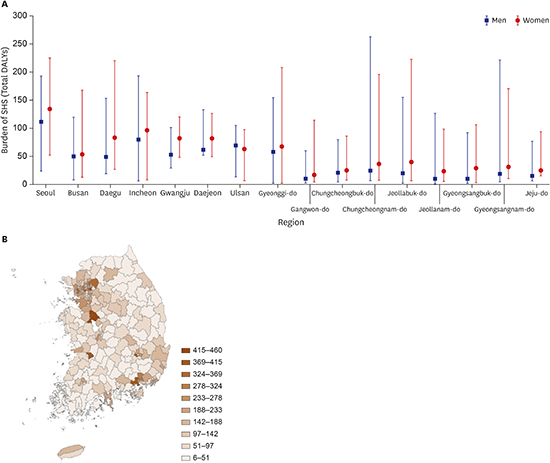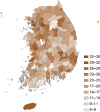1. Ng M, Freeman MK, Fleming TD, Robinson M, Dwyer-Lindgren L, Thomson B, et al. Smoking prevalence and cigarette consumption in 187 countries, 1980–2012. JAMA. 2014; 311(2):183–192.

2. Heo S, Lee JT. Disease burdens from environmental tobacco smoke in Korean adults. Int J Environ Health Res. 2015; 25(3):330–348.

3. Jee SH, Ohrr H, Kim IS. Effects of husbands' smoking on the incidence of lung cancer in Korean women. Int J Epidemiol. 1999; 28(5):824–828.

4. Kim WJ, Song JS, Park DW, Kwak HJ, Moon JY, Kim SH, et al. The effects of secondhand smoke on chronic obstructive pulmonary disease in nonsmoking Korean adults. Korean J Intern Med. 2014; 29(5):613–619.

5. Park S, Jee SH, Shin HR, Park EH, Shin A, Jung KW, et al. Attributable fraction of tobacco smoking on cancer using population-based nationwide cancer incidence and mortality data in Korea. BMC Cancer. 2014; 14(1):406.

6. Zahra A, Cheong HK, Lee EW, Park JH. Burden of disease attributable to secondhand smoking in Korea. Asia Pac J Public Health. 2016; 28(8):737–750.

7. Forouzanfar MH, Alexander L, Anderson HR, Bachman VF, Biryukov S, Brauer M, et al. Global, regional, and national comparative risk assessment of 79 behavioural, environmental and occupational, and metabolic risks or clusters of risks in 188 countries, 1990–2013: a systematic analysis for the Global Burden of Disease Study 2013. Lancet. 2015; 386(10010):2287–2323.
8. Sun LY, Cheong HK, Lee EW, Kang KJ, Park JH. Affecting factors of secondhand smoke exposure in Korea: focused on different exposure locations. J Korean Med Sci. 2016; 31(9):1362–1372.

9. Mackay D, Haw S, Ayres JG, Fischbacher C, Pell JP. Smoke-free legislation and hospitalizations for childhood asthma. N Engl J Med. 2010; 363(12):1139–1145.

10. Callinan JE, Clarke A, Doherty K, Kelleher C. Legislative smoking bans for reducing secondhand smoke exposure, smoking prevalence and tobacco consumption. Cochrane Database Syst Rev. 2010; (4):CD005992.

11. Institute for Health Metrics and Evaluation. GBD Country Profiles. Seattle, WA: Institute for Health Metrics and Evaluation, University of Washington;2015. Updated 2015. Accessed October 27, 2015.
http://www.healthdata.org/results/country-profiles.
12. Zahra A, Cheong HK, Park JH. Burden of disease attributable to smoking in Korea. Asia Pac J Public Health. 2017; 29(1):47–59.

13. Jee SH, Suh I, Kim IS, Appel LJ. Smoking and atherosclerotic cardiovascular disease in men with low levels of serum cholesterol: the Korea Medical Insurance Corporation Study. JAMA. 1999; 282(22):2149–2155.
14. Jee SH, Park J, Jo I, Lee J, Yun S, Yun JE, et al. Smoking and atherosclerotic cardiovascular disease in women with lower levels of serum cholesterol. Atherosclerosis. 2007; 190(2):306–312.

15. Norman RE, Vos T, Barendregt JJ, Linh BN, Huong NT, Higashi H, et al. Mortality attributable to smoking in Vietnamese men in 2008. Prev Med. 2013; 57(3):232–237.

16. Oza S, Thun MJ, Henley SJ, Lopez AD, Ezzati M. How many deaths are attributable to smoking in the United States? Comparison of methods for estimating smoking-attributable mortality when smoking prevalence changes. Prev Med. 2011; 52(6):428–433.

17. Öberg M, Woodward A. Global Estimate of the Burden of Disease from Second-Hand Smoke. Geneva: World Health Organization;2010.
20. Thun MJ, Hannan LM, Adams-Campbell LL, Boffetta P, Buring JE, Feskanich D, et al. Lung cancer occurrence in never-smokers: an analysis of 13 cohorts and 22 cancer registry studies. PLoS Med. 2008; 5(9):e185.

21. Ock M, Lee JY, Oh IH, Park H, Yoon SJ, Jo MW. Disability weights measurement for 228 causes of disease in the Korean Burden of Disease Study 2012. J Korean Med Sci. 2016; 31:Suppl 2. S129–S138.

22. Jemal A, Thun M, Yu XQ, Hartman AM, Cokkinides V, Center MM, et al. Changes in smoking prevalence among U.S. adults by state and region: estimates from the tobacco use supplement to the current population survey, 1992–2007. BMC Public Health. 2011; 11(1):512.

23. Cai L, Wu X, Goyal A, Han Y, Cui W, He J, et al. Multilevel analysis of the determinants of smoking and second-hand smoke exposure in a tobacco-cultivating rural area of southwest China. Tob Control. 2013; 22:Suppl 2. ii16–ii20.

24. Harris JK, Geremakis C, Moreland-Russell S, Carothers BJ, Kariuki B, Shelton SC, et al. Demographic and geographic differences in exposure to secondhand smoke in Missouri workplaces, 2007–2008. Prev Chronic Dis. 2011; 8(6):A135.
26. Institute for Health Metrics and Evaluation. GBD Compare. Seattle, WA: Institute for Health Metrics and Evaluation, University of Washington;2015.
27. Coughlin SS, Thompson TD, Hall HI, Logan P, Uhler RJ. Breast and cervical carcinoma screening practices among women in rural and nonrural areas of the United States, 1998–1999. Cancer. 2002; 94(11):2801–2812.

28. Doescher MP, Jackson JE. Trends in cervical and breast cancer screening practices among women in rural and urban areas of the United States. J Public Health Manag Pract. 2009; 15(3):200–209.









 PDF
PDF Citation
Citation Print
Print






 XML Download
XML Download